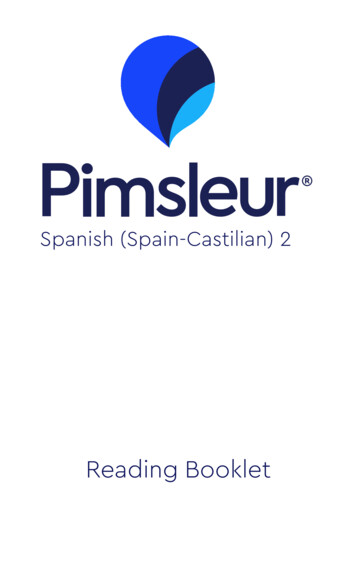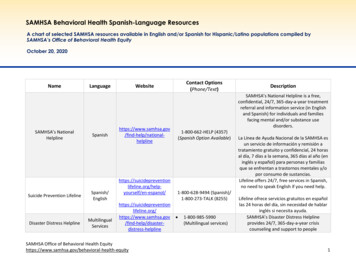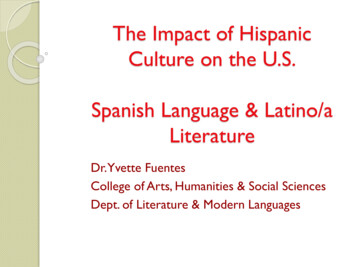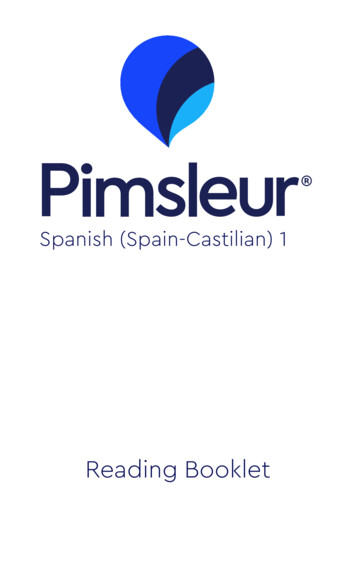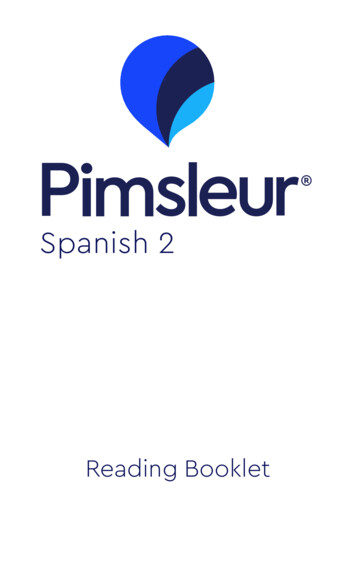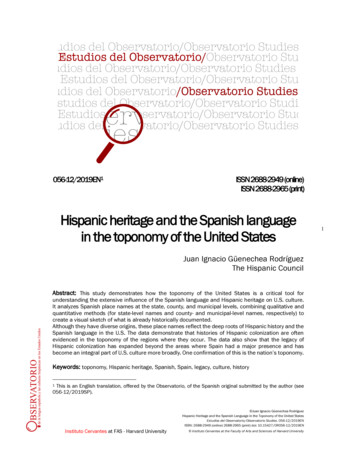
Transcription
056-12/2019EN1ISSN 2688-2949 (online)ISSN 2688-2965 (print)Hispanic heritage and the Spanish languagein the toponomy of the United StatesJuan Ignacio Güenechea RodríguezThe Hispanic CouncilAbstract: This study demonstrates how the toponomy of the United States is a critical tool forunderstanding the extensive influence of the Spanish language and Hispanic heritage on U.S. culture.It analyzes Spanish place names at the state, county, and municipal levels, combining qualitative andquantitative methods (for state-level names and county- and municipal-level names, respectively) tocreate a visual sketch of what is already historically documented.Although they have diverse origins, these place names reflect the deep roots of Hispanic history and theSpanish language in the U.S. The data demonstrate that histories of Hispanic colonization are oftenevidenced in the toponomy of the regions where they occur. The data also show that the legacy ofHispanic colonization has expanded beyond the areas where Spain had a major presence and hasbecome an integral part of U.S. culture more broadly. One confirmation of this is the nation’s toponomy.Keywords: toponomy, Hispanic heritage, Spanish, Spain, legacy, culture, historyThis is an English translation, offered by the Observatorio, of the Spanish original submitted by the author (see056-12/2019SP).1 Juan Ignacio Güenechea RodríguezHispanic Heritage and the Spanish Language in the Toponomy of the United StatesEstudios del Observatorio/Observatorio Studies. 056-12/2019ENISSN: 2688-2949 (online) 2688-2965 (print) doi: 10.15427/OR056-12/2019ENInstituto Cervantes at FAS - Harvard University Instituto Cervantes at the Faculty of Arts and Sciences of Harvard University1
2 Juan Ignacio Güenechea RodríguezHispanic Heritage and the Spanish Language in the Toponomy of the United StatesEstudios del Observatorio/Observatorio Studies. 056-12/2019ENISSN: 2688-2949 (online) 2688-2965 (print) doi: 10.15427/OR056-12/2019ENInstituto Cervantes at FAS - Harvard University Instituto Cervantes at the Faculty of Arts and Sciences of Harvard University
1. IntroductionThere has been a rich and extensive Hispanic presence in the United States sincePonce de León arrived on the coast of Florida. Beginning in that moment, andcontinuing through Spain’s sale of Florida in 1821 over three centuries later, aHispanic legacy became deeply ingrained in what is now known as the United States.This is clear from the use by many cities and states of symbols that harken backto their Hispanic legacy, both in cities founded by the Spaniards—such as St. Augustine,the oldest continuously inhabited city in the country—as well as due to Spain’s manyimportant expeditions in the territory, which created a network of roads andinfrastructure that proved vital to the early development of many regions.This broad Hispanic heritage is even clear in the names of many places.Toponomy is a critical tool for understanding the history and culture of any territory.Directly or indirectly, place names tell a story, given that “after their imposition at agiven historical moment, they become fixed and offer an image of that place during apast period” (Molina, 2012).Springboarding from that point, this study aims to analyze the names of states,counties, and municipalities in order to shed light on the profound Hispanic influencethat has helped characterize the U.S.Territories might acquire Spanish or Spanish-derived names for any number ofreasons. An analysis could focus on names that are directly rooted in the colonial pastof their corresponding locations, such as Los Angeles or San Francisco, but such ananalysis would neglect towns like Estrella, Arizona, which was founded after Spain’swithdrawal from U.S. territory but which, due to widespread colonial influence, stillchose a Spanish name. Juan Ignacio Güenechea RodríguezHispanic Heritage and the Spanish Language in the Toponomy of the United StatesEstudios del Observatorio/Observatorio Studies. 056-12/2019ENISSN: 2688-2949 (online) 2688-2965 (print) doi: 10.15427/OR056-12/2019ENInstituto Cervantes at FAS - Harvard University Instituto Cervantes at the Faculty of Arts and Sciences of Harvard University3
There is also a third category of Spanish place names: faux constructionsdesigned to give an area the aura of colonial or Hispanic origins. These names wereusually coined by non-Spanish speakers, and many contain grammatical errors orartificial constructions. In Florida, for example, there are numerous Spanish toponymsthat are actually “artificial, incorrect, and even laughable names given by landdevelopers in an effort to draw tourists from the north” (Hamilton, 1968, p. 431). Onesuch ploy is the town of Los Gatos (“The Cats”), whose name actually comes from theEnglish “The Gates.”Given these diverse origins, it seems clear that analyzing Hispanic toponomy inthe U.S. is no simple task. Further complicating matters are English-language placenames that have Hispanic origins, but which were introduced through translation.It is also worth acknowledging a category of toponyms that, despite the lack ofan etymological connection, nevertheless have close cultural ties to the Hispaniclexicon: the cities and municipalities called Columbia and Columbus.Clearly, localities with this name have a direct link to the man who “discovered”the Americas and whose history is inextricably tied to that of Spain.Columbia was first adopted in the 18th century. A Latinization of Columbus—which is, in turn, an English translation of the Italian Colombo—it evokes the old Latinnames of European territories, such as Britannia or Gallia, though, unlike in thoseexamples, a noun (a name) is used to refer to a geographic region. As Higham (1990)explains: “Columbia was the invention of poets who wanted to refer to the youngrepublic in language with all of the latinized dignity conveyed by ‘Britannia’” (p. 63).This term entailed a personification of the thirteen colonies. Many writers used thename to refer to what would later become the U.S., and it became popular in Americansociety. Juan Ignacio Güenechea RodríguezHispanic Heritage and the Spanish Language in the Toponomy of the United StatesEstudios del Observatorio/Observatorio Studies. 056-12/2019ENISSN: 2688-2949 (online) 2688-2965 (print) doi: 10.15427/OR056-12/2019ENInstituto Cervantes at FAS - Harvard University Instituto Cervantes at the Faculty of Arts and Sciences of Harvard University4
This study will consider the terms Columbus and Columbia as part of the U.S.’s“Hispanic” toponomy. Without the Spanish Crown’s key decision to fund Columbus’svoyage, the Genoese explorer would never have reached the Americas. It follows, then,that toponyms alluding to him would not have existed if Spain had not sponsored hisexpedition. Thus, I have included these place names in this analysis.As this study does not aim to perform a conventional toponymic analysis, butrather to perform an x-ray of Hispanic toponomy in the U.S. and thereby highlight thecountry’s significant Hispanic heritage, I have included: 1) all place names that relateto the country’s Spanish colonial past; 2) all Spanish-language place names,regardless of their historic relationship with the Hispanosphere (such as Sierra Vista,California, which did not receive that name until 1961, after numerous changes); and3) all those that, though they are in English, nevertheless have origins in the U.S.’sHispanic cultural heritage.For example, though a city or municipality’s Spanish-language name may nothave strictly Hispanic roots, I have nevertheless included that name in the study, as it,too, reflects the U.S.’s broader Hispanic legacy. The fact that certain places are givenSpanish names—even if only for the sake of attracting tourists—still typifies thepenetration of the Spanish language and the Hispanic legacy in the U.S.To that end, this study analyzes the toponyms of all U.S. states, counties, andother incorporated places. These levels of analysis were selected in an attempt toachieve the greatest possible homogeneity, as the administrative disparity betweensome states can interfere with a proper comparison, especially on the municipal level. Juan Ignacio Güenechea RodríguezHispanic Heritage and the Spanish Language in the Toponomy of the United StatesEstudios del Observatorio/Observatorio Studies. 056-12/2019ENISSN: 2688-2949 (online) 2688-2965 (print) doi: 10.15427/OR056-12/2019ENInstituto Cervantes at FAS - Harvard University Instituto Cervantes at the Faculty of Arts and Sciences of Harvard University5
2. The Hispanic Toponomy of the United StatesFew are aware that at least 15% of the U.S.’s fifty state names were derived from thecountry’s Hispanic past. That percentage could be even higher if we include stateswhose names are of uncertain origin, such as Arizona and Oregon, as some theoriesargue that these, too, have Spanish roots.Below, we consider those states whose names are derived from Spanish, orfrom their territory’s Hispanic heritage.2.1 CaliforniaThere has been a Hispanic presence in California since 1542, when the first Europeanship made landfall on the west coast of the present-day U.S. It was a Spanish shipknown as the San Salvador, led by Juan Rodríguez Cabrillo (Kramer, 2018). He arrivedin San Diego Bay, in Southern California, in September of that year, and claimed theterritory for Spain upon his arrival.However, Spain did not erect a stable settlement in the region until over 200years later: California was far away and isolated, and the Crown’s interest in occupyingthe territory waned. News that Russian traders were beginning to descend from thenorth finally expedited the process and prompted the “Sacred Expedition” to exploreAlta California (of which 2019 is the 250th anniversary; Eldredge & De Ayala, 1909).This expedition, which was led by Gaspar de Portolà and in which the FranciscanJunípero Serra played a key role, would ultimately result in the founding of San Diegoin 1769, and of many other missions throughout the territory (though not without somechallenges). These outposts stabilized and strengthened the Spanish presence in theregion. Juan Ignacio Güenechea RodríguezHispanic Heritage and the Spanish Language in the Toponomy of the United StatesEstudios del Observatorio/Observatorio Studies. 056-12/2019ENISSN: 2688-2949 (online) 2688-2965 (print) doi: 10.15427/OR056-12/2019ENInstituto Cervantes at FAS - Harvard University Instituto Cervantes at the Faculty of Arts and Sciences of Harvard University6
In terms of the state’s name, it is important to note that it was not only appliedto the region that is now the State of California, but also to Baja California, in presentday Mexico. The most commonly accepted theory is that the name was taken from thenovel Las sergas de Esplandián by Garcí Rodríguez de Montalvo, which waspublished in 1510. The book describes an imaginary, idyllic place calledCalifornia, where riches were bountiful. Spanish explorers thought the region wasquite close to Montalvo’s description, and named it accordingly. In the novel,Rodríguez de Montalvo writes: “Known, that on the right hand of the Indies thereis an island called California very close to the side of the Terrestrial Paradise”(cited in Turner, 2011, p. 84).2A different, less popular account identifies a Hispanic origin for the name byassociating the territory with the expeditions of Hernán Cortés, who described theregion as “hot as an oven.” Missionaries transformed the phrase into the Latin calidafornax (Niemann, 2002). This theory posits that the name would have gained tractionwith subsequent explorers; the first theory remains more popular.2.2 ColoradoMost historians believe that in 1539, the explorer Francisco de Ulloa “discovered” themouth of the Colorado River on a sea voyage. Vázquez de Coronado’s expedition wasthe first to reach the Grand Canyon by land; specifically, it was García López deCárdenas who first encountered what they called “a big drop,” down which they wereultimately unable to climb due to the steep terrain. From the top of canyon, they wereable to see the Colorado River, which looked like a small stream from such a highaltitude.Some sources affirm that this description of the state appears in a different novel by Rodríguez de Montalvo,Amadis de Gaula (1503). See, for example, Turner, 2011, p. 84.2 Juan Ignacio Güenechea RodríguezHispanic Heritage and the Spanish Language in the Toponomy of the United StatesEstudios del Observatorio/Observatorio Studies. 056-12/2019ENISSN: 2688-2949 (online) 2688-2965 (print) doi: 10.15427/OR056-12/2019ENInstituto Cervantes at FAS - Harvard University Instituto Cervantes at the Faculty of Arts and Sciences of Harvard University7
At the same time, the navigator Hernando de Alarcón was sent to providemaritime support to Vázquez de Coronado’s expedition. In doing so, he traveled astretch of the Colorado River, which he called the Buena Guía (Trillo Lodeiro, 2019),though he did not succeed in connecting with the explorers from the land expedition.All of this is relevant, as those expeditions ultimately established the name ofthe Colorado River, which was later applied to the state. The word colorado is clearlySpanish; it was used to describe the reddish color of the river itself. The early Spanishexplorers of the Rocky Mountain region who encountered the river called it tizón orcolorado because of the sediment the river dragged down from the mountains. Thus,with time, the name became established for both the river and the state thanks to thecolor of the water.2.3 FloridaSince Ponce de León’s “discovery” of present-day Florida in 1513, there has been anextensive Spanish presence in the region. A number of expeditions took place there,including those of Vázquez de Ayllón, Pánfilo de Narváez, Alvar Núñez Cabeza de Vaca,and Hernando de Soto, and attempts to establish settlements began with the earliesttrips, though their efforts were hampered by the harsh climate and hostility fromindigenous peoples.One of the most important documents in the history of the U.S.’s Hispaniclegacy was penned in 1565, when Pedro Menéndez de Avilés founded St. Augustine,in Florida. Today, as is widely known, St. Augustine is the U.S.’s oldest continuouslyinhabited city.This long history is evidenced by many of Florida’s symbols, including its flag,and many of its cities’ coats of arms. The word Florida, too, is closely linked to thisHispanic heritage. Juan Ignacio Güenechea RodríguezHispanic Heritage and the Spanish Language in the Toponomy of the United StatesEstudios del Observatorio/Observatorio Studies. 056-12/2019ENISSN: 2688-2949 (online) 2688-2965 (print) doi: 10.15427/OR056-12/2019ENInstituto Cervantes at FAS - Harvard University Instituto Cervantes at the Faculty of Arts and Sciences of Harvard University8
One theory posits that Ponce de León gave the territory its name due to theabundant and colorful vegetation, but the most widely accepted theory amonghistorians is that the name is linked to the day Ponce de León “discovered” the region:Easter Sunday, or Pascua Florida.2.4 MontanaSpanish presence in Montana was less relevant than it was in other sites across NorthAmerica, but the Hispanic legacy is still discernible. For instance, the state’s motto,“Oro y Plata,” is Spanish; it appears on the state flag and state seal.However, the clearest expression of Montana’s ties to Hispanic culture andheritage is its name, which is derived from the Spanish montaña. The earliest Spanishexplorers in the mountainous region called it Montaña del Norte (Malone et al, 1991).Ironically, the state would eventually be named after this early colonialdesignation, despite the fact that it has an average elevation of only 1,030 meters, thelowest of the Mountain States.This was a point of some contention when it came time to choose a name forthe state. In 1864, when Ohio Congressman James Ashley proposed a bill that wouldestablish a temporary government for a new territory that was to be carved out ofIdaho, he chose the name Montana. Representative Samuel Cox, also of Ohio,objected to the name, claiming that it was a misnomer, given that most of the territorywas not mountainous. But Ashley’s bill ultimately prevailed, and the name wasadopted.3Information obtained from: Congressional Globe, House of Representatives, 38th Congress, 1st Session. U.S.Congressional Documents and Debates, 1774 – 1875.3 Juan Ignacio Güenechea RodríguezHispanic Heritage and the Spanish Language in the Toponomy of the United StatesEstudios del Observatorio/Observatorio Studies. 056-12/2019ENISSN: 2688-2949 (online) 2688-2965 (print) doi: 10.15427/OR056-12/2019ENInstituto Cervantes at FAS - Harvard University Instituto Cervantes at the Faculty of Arts and Sciences of Harvard University9
2.5 NevadaWhat would become a stable Spanish presence in Nevada was established in the mid18th century, when Spanish explorers and Franciscans started conducting expeditionsinto the territory and settling there. The Franciscan missionary Francisco Garcés, bornin Morata del Conde, Aragon, is believed to be the first European to set foot in the area.Thus, present-day Nevada became part of the Viceroyalty of New Spain’sCommandancy and General Captaincy of the Internal Provinces. Nevada joined theprovince of Alta California in 1804, when Alta California and Baja California weredivided. It later became a part of Mexico—along with the rest of the Alta Californiaregion—after the Mexican War of Independence, in 1821.The state’s name refers to the abundance of snow in its mountains. It was theSpanish priest Pedro Font, who was part of Juan de Oñate’s second expedition, whochose the name Sierra Nevada (“snowy range”) for a mountain range located partiallyin present-day Nevada, though the bulk of the Sierra Nevada actually lies in California.That geographical feature’s name later extended to the state.2.6 New MexicoFrom the outset of Spain’s exploration in North America, New Mexico had a vastSpanish presence. On his search for the Seven Cities of Gold, Vázquez de Coronado(mentioned above) was the first to lead an expedition through the region. The fictitiousSeven Cities of Gold were imagined to be filled with riches, a fact that garneredsignificant interest among explorers. Early Spanish expeditions of the present-dayU.S.’s Southwest region took special interest in the legend, as some explorers claimedto have seen the cities, prompting journeys such as Vázquez de Coronado’s. Juan Ignacio Güenechea RodríguezHispanic Heritage and the Spanish Language in the Toponomy of the United StatesEstudios del Observatorio/Observatorio Studies. 056-12/2019ENISSN: 2688-2949 (online) 2688-2965 (print) doi: 10.15427/OR056-12/2019ENInstituto Cervantes at FAS - Harvard University Instituto Cervantes at the Faculty of Arts and Sciences of Harvard University10
However, the explorer Francisco de Ibarra was the first to posit the name NuevoMéxico for the region, as he was already familiar with the Mexican territory, and thesimilarity in the terrain led him to describe what he saw as a “new Mexico” (Stewart,2008). In fact, the area Ibarra described was to the south of present-day New Mexico,but the name became etched in the in the memory of future conquistadors. On thesubsequent Chamuscado and Rodríguez Expedition, the region to the north of the RioGrande was dubbed San Felipe del Nuevo México.In 1598, it was Juan de Oñate who officially established the name NuevoMéxico upon being appointed the first governor of the newly founded Province ofNuevo México. The territory’s first permanent European settlement, the San Juan delos Caballeros colony, was established that same year.The word México derives from Nahuatl and originally referred to the Valley ofMexico, near present-day Mexico City; we received the current word through a processof Castilianization. The country of Mexico did not have that name until it won itsindependence in 1821, prior to which México was used only to refer to the regiondescribed above.2.7 TexasIn 1528, Álvar Núñez Cabeza de Vaca led first European expedition of Texas. Later,Alonso Álvarez de Pineda mapped the Texas coast. These events underscore how thehistory of Texas cannot be understood apart from its Hispanic legacy. Even so, theFrench were the first Europeans to consistently occupy and populate the territory, withSpain’s chapter of domination arriving later, from 1690 to 1821.During the latter period, the Spanish empire established numerous settlementsand missions that would grow into cities, including San Antonio. One of the mostimportant milestones was the establishment of the Camino Real de los Tejas, a road Juan Ignacio Güenechea RodríguezHispanic Heritage and the Spanish Language in the Toponomy of the United StatesEstudios del Observatorio/Observatorio Studies. 056-12/2019ENISSN: 2688-2949 (online) 2688-2965 (print) doi: 10.15427/OR056-12/2019ENInstituto Cervantes at FAS - Harvard University Instituto Cervantes at the Faculty of Arts and Sciences of Harvard University11
network that connected Spanish missions and populations, and which was critical tothe settlement, development, and history of Texas.The name Texas originated in the indigenous Caddo language of what is noweast Texas. The Caddo used the word taysha, which meant “friends” or “allies.” TheSpaniards Castilianized this expression, transforming it into Texas or Tejas (Bright,2004), which had the same pronunciation in Old Castilian. Therefore, the modernEnglish-language pronunciation of the word is etymologically incorrect in Spanish.Although this is the most commonly accepted theory, there are also researcherswho maintain that the toponym originates directly from the Spanish word teja (tile).According to this theory, the plural would have been used to describe the indigenouscamps, and the term was later generalized to describe the entire territory.2.8 Utah12As in Montana, the Spanish colonial presence in Utah was not as prominent as in otherstates analyzed here. Vázquez de Coronado’s expedition to find the Seven Cities ofGold was the first to penetrate the southern portion of the territory.Over two centuries later, in 1776, Spanish priests Atanasio Domínguezand Silvestre Vélez de Escalante led a group out of Santa Fe, hoping to find a route tothe California coast. The expedition reached the northern Utah Lake region, where theyencountered indigenous populations. They did not consider the territory sufficientlyinteresting to establish the stable settlements and road networks they had builtelsewhere, given the barren and arduous terrain.The state name derives from the Apache Yuttahih or Yuddah, which means“higher up” or “those that are higher up.” Spanish explorers pronounced and wrotethis word Yuta, which English speakers later transformed into Utah. Juan Ignacio Güenechea RodríguezHispanic Heritage and the Spanish Language in the Toponomy of the United StatesEstudios del Observatorio/Observatorio Studies. 056-12/2019ENISSN: 2688-2949 (online) 2688-2965 (print) doi: 10.15427/OR056-12/2019ENInstituto Cervantes at FAS - Harvard University Instituto Cervantes at the Faculty of Arts and Sciences of Harvard University
2.9 Arizona and OregonAlthough there is no single hypothesis regarding the origins of most of the state namesanalyzed above, there is a leading theory for each that closely links it to Spanish or aHispanic legacy. In the cases of Arizona and Oregon, the consensus is not as strong,for which reason they are included here as a separate section.In the case of Arizona, one theory posits that the name derives from theindigenous term alĭ sonak, which means “little spring” (McClintock, 1916). The earlySpanish explorers of the territory would have Castilianized the expression, creatingArizonac, which, over time, became Arizona.Others argue that a similar process took place, but that the original indigenousterm was Al Shon (Saxton et al, 1983). Finally, Donald T. Garate (2005) believes thatnone of this ever took place and that the word Arizonac is simply a 20th-centuryetymological error unrelated to Hispanic influence or Castilianized indigenous terms,and that the name has a completely different origin: Basque. Most of the region’s earlyexplorers had Basque roots and, given the abundance of oak trees in certain areas,some believe that the name Arizona may have stemmed from the Basque words Aritzonak, which literally means “good oaks” (Garate, 1999).There are also diverse theories regarding the origins of Oregon, some of whichassociate the name with the state’s Hispanic heritage and the Spanish language.However, the leading theory argues that the name comes from the Frenchouragan (hurricane or windstorm), which would have been based on Native Americanstories about the region’s powerful Chinook winds (Elliot, 1922).The most widely accepted theory that also links the name to Spain suggeststhat Oregon came from orejón (rough, coarse), a term that may have described the Juan Ignacio Güenechea RodríguezHispanic Heritage and the Spanish Language in the Toponomy of the United StatesEstudios del Observatorio/Observatorio Studies. 056-12/2019ENISSN: 2688-2949 (online) 2688-2965 (print) doi: 10.15427/OR056-12/2019ENInstituto Cervantes at FAS - Harvard University Instituto Cervantes at the Faculty of Arts and Sciences of Harvard University13
region’s indigenous people or geographic features. There is also some speculation thatthe name may come from the Spanish orégano, as the herb grows in the southernportion of the region. Alternatively, the territory may have been named after someSpanish populations that bore the name Oregón, like the “Arroyo del Oregón” in CiudadReal, Spain (Johnson, 1904).Despite the lively debate surrounding the exact origin of the name, it isundeniable that Spanish presence in Oregon was not as extensive or intense as inother regions of the present-day U.S. Thus, it would not be a surprise if the trueetymological origin were French, as the leading theory holds.2.10 Other TerritoriesAside from states, there are other U.S. territories whose toponomy is clearly marked byHispanic influence, such as:14§Puerto Rico: Although the Europeans’ first name for the island was San JuanBautista, this was later changed to Puerto Rico, which refers to the island’sabundant riches; the name is unequivocally Spanish, due to the Spanishpresence on the island.§Northern Mariana Islands: This archipelago was named after Mariana ofAustria, who was queen of Spain in the 18th century. Explorers originally calledthem the “Islands of Thieves.”§The Virgin Islands: The islands were given their name by Christopher Columbus,who dubbed them the “Islands of the Eleven Thousand Virgins” on his voyages.This was later shortened to the Virgin Islands and, today, they are officially theVirgin Islands of the United States (more commonly the U.S. Virgin Islands) todistinguish them from their British counterparts.§The District of Columbia: As explained earlier, this name comes from aLatinization of the English version of Christopher Columbus’s surname. Juan Ignacio Güenechea RodríguezHispanic Heritage and the Spanish Language in the Toponomy of the United StatesEstudios del Observatorio/Observatorio Studies. 056-12/2019ENISSN: 2688-2949 (online) 2688-2965 (print) doi: 10.15427/OR056-12/2019ENInstituto Cervantes at FAS - Harvard University Instituto Cervantes at the Faculty of Arts and Sciences of Harvard University
3. Counties and MunicipalitiesThe analysis in this section will be limited to U.S. counties and municipalities. It isimportant to note, though it will be explained in greater detail below, that in order tomake a satisfactory comparison, I have attempted to homogenize these levels ofgovernment despite each state’s unique characteristics.In the analysis of state names, we focused on the colonial origins of placenames, as most toponyms associated with the country’s Hispanic roots wereestablished during the colonial period. At the lower levels of government, however, wefind place names with more mixed origins, including some localities with post-colonialHispanic names and others with faux Spanish constructions.As stated above, the analysis at this level is more generic and less etymologicalor historiographic. The goal is to find a didactic yet rigorous way to describe the reachof Hispanic heritage through place names, regardless of their origin.3.1 CountiesIn the U.S., counties are the next form of administrative organization after states. Fortyeight of the fifty states are divided into counties, while Louisiana and Alaska are dividedinto other kinds of entities with the same function.In Louisiana, these administrative units are known as parishes, owing to themajor French and Spanish influence in the region since the arrival of Europeans in the16th century. For over 200 years, local governments were based on ecclesiasticaldivisions such as parishes, or paroisse in French, which eventually turned into presentday parishes. They were established as the official administrative unit of Louisiana inthe early 19th century, and the state is now divided into sixty-four of them. Alaska, onthe other hand, uses boroughs. It is currently divided into nineteen organized Juan Ignacio Güenechea RodríguezHispanic Heritage and the Spanish Language in the Toponomy of the United StatesEstudios del Observatorio/Observatorio Studies. 056-12/2019ENISSN: 2688-2949 (online) 2688-2965 (print) doi: 10.15427/OR056-12/2019ENInstituto Cervantes at FAS - Harvard University Instituto Cervantes at the Faculty of Arts and Sciences of Harvard University15
boroughs, though these do not cover the entirety of the state; the remaining territoryis known as the Unorganized Borough. It is worth noting that the word borough derivesfrom the Old English burh, which means “fortified settlement” (Lavelle, 2003).Additionally, there are some parts of the country that are designated
Hispanic heritage and the Spanish language in the toponomy of the United States Juan Ignacio Güenechea Rodríguez The Hispanic Council Abstract: This study demonstrates how the toponomy of the United States is a critical tool for understanding the extensive influence of the Spanish
